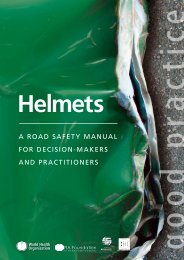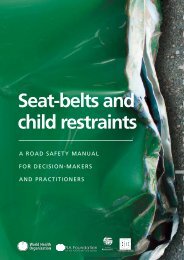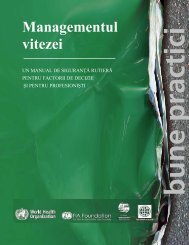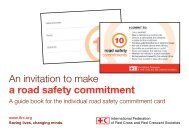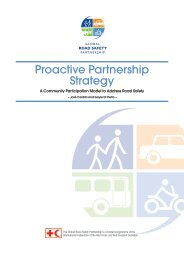How to design and implement a drinking and driving programme pdf ...
How to design and implement a drinking and driving programme pdf ...
How to design and implement a drinking and driving programme pdf ...
Create successful ePaper yourself
Turn your PDF publications into a flip-book with our unique Google optimized e-Paper software.
The enforcement process<br />
Drinking <strong>and</strong> Driving: a road safety manual<br />
Effective <strong>and</strong> efficient law enforcement interventions are critical in achieving a<br />
reduction in road trauma <strong>and</strong> do not necessarily require high-cost, modern technology<br />
or a huge resource commitment. Enforcement should be “intelligence-led”,<br />
which requires:<br />
• acknowledging <strong>and</strong> underst<strong>and</strong>ing the <strong>drinking</strong> <strong>and</strong> <strong>driving</strong> problem through data<br />
collection <strong>and</strong> analysis;<br />
• underst<strong>and</strong>ing community perceptions <strong>and</strong> political commitment regarding<br />
<strong>drinking</strong> <strong>and</strong> <strong>driving</strong>. Public pressure on politicians can lead <strong>to</strong> greater support for<br />
more intense enforcement of <strong>drinking</strong> <strong>and</strong> <strong>driving</strong> laws. Political will is critical in<br />
ensuring consistent community education <strong>and</strong> the enforcement of <strong>drinking</strong> <strong>and</strong><br />
<strong>driving</strong> laws.<br />
• exp<strong>and</strong>ing the <strong>programme</strong> slowly based on lessons learned in pilot communities.<br />
Pilot <strong>programme</strong>s enforcing drink-<strong>driving</strong> laws should be undertaken in communities<br />
where there is known political <strong>and</strong> community commitment <strong>to</strong> reducing the<br />
incidence of <strong>drinking</strong> <strong>and</strong> <strong>driving</strong>.<br />
3 | <strong>How</strong> <strong>to</strong> <strong>design</strong> <strong>and</strong> <strong>implement</strong> a <strong>drinking</strong> <strong>and</strong> <strong>driving</strong> <strong>programme</strong><br />
Data that can guide intelligence-led enforcement<br />
• Accurate statistics on fatalities, serious injuries, injuries <strong>and</strong> crashes, <strong>and</strong> the<br />
role alcohol plays as a causal fac<strong>to</strong>r.<br />
• Crash data as it relates <strong>to</strong> times of the day, days of the week <strong>and</strong> particularly<br />
critical locations. If presented in an appropriate format, this data will provide<br />
the profile on high alcohol times, days of the week <strong>and</strong> locations upon which<br />
<strong>to</strong> focus police resources for maximum effect.<br />
• Accurate statistics on the amount of alcohol consumed by offending drivers.<br />
• The locations where drivers consumed the alcohol – this information can assist<br />
with targeted enforcement <strong>and</strong> educational intervention campaigns.<br />
• Blood alcohol readings of drivers admitted <strong>to</strong> hospital.<br />
• The BAC readings obtained from apprehended offenders.<br />
• The <strong>to</strong>xicology reports from the coroner’s court relative <strong>to</strong> all deceased drivers.<br />
• The identification of high-risk user groups by age or social st<strong>and</strong>ing, thereby<br />
assisting strategies for targeted enforcement <strong>and</strong> specific education.<br />
• Data collected must be accurate <strong>and</strong> analysed for trends <strong>to</strong> determine<br />
enforcement strategies <strong>and</strong>, most importantly, must be maintained for<br />
assessing performance outcomes.<br />
81






